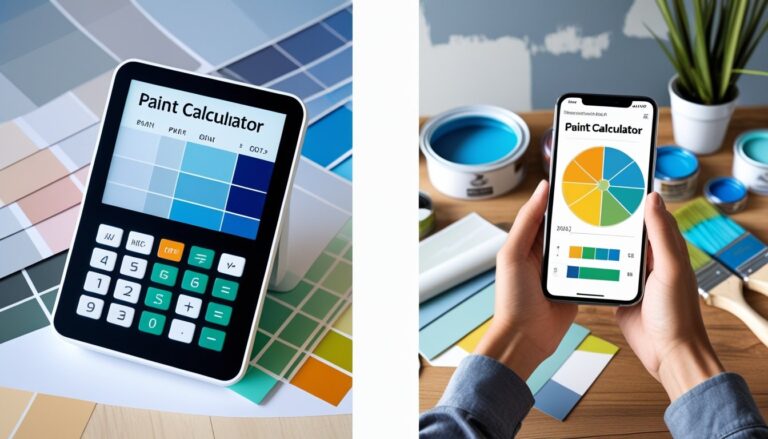How to Start a Garden from Scratch: Step-by-Step Guide for Beginners to Achieve Successful Growth
Starting a garden from scratch can seem overwhelming, but it is a rewarding process anyone can manage with the right steps. The key to a successful garden is choosing the right spot, preparing the soil well, and selecting plants suited to the area’s climate. These basics create a strong foundation for healthy growth and a productive garden.
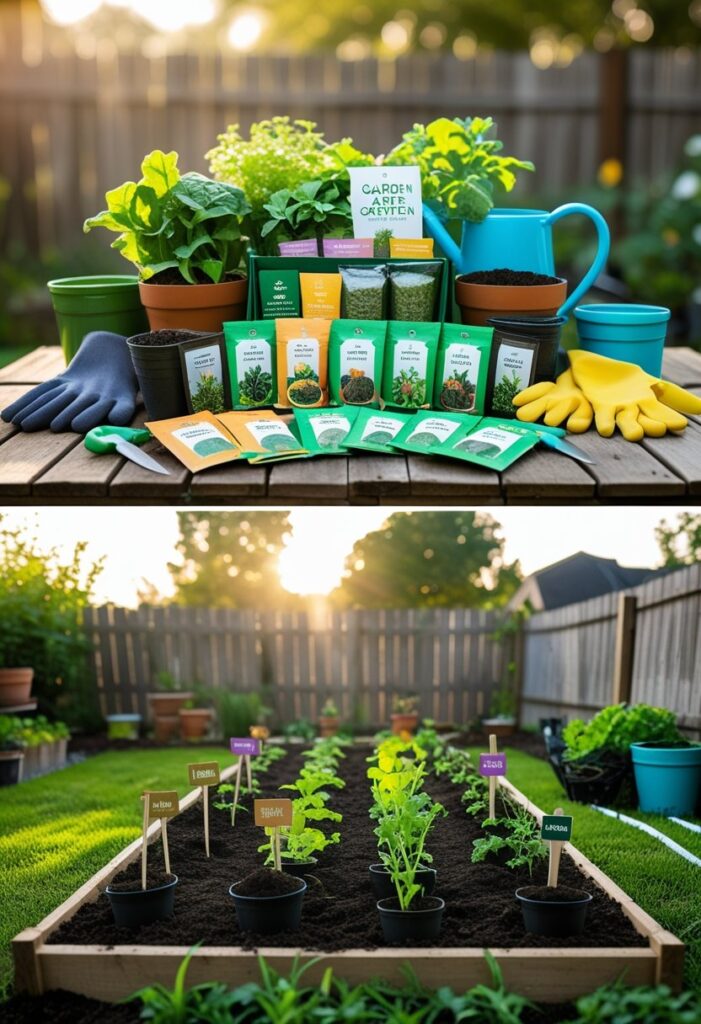
Gardening doesn’t require expensive tools or a large space, just some careful planning and consistent care. Understanding how to prepare the soil, plant seeds or seedlings, and maintain the garden will help beginners grow plants that thrive. This guide will walk readers through those essential steps clearly and simply.
With patience and step-by-step instructions, even someone new to gardening can create a green space that brings satisfaction and fresh produce or flowers. The process is manageable and worth the effort for anyone ready to try.
Key Takeways
- Choosing the right location and preparing the soil are crucial first steps.
- Proper planting and regular care promote healthy garden growth.
- Consistent maintenance helps protect plants and improve yields.
Planning Your Garden: Essential First Steps
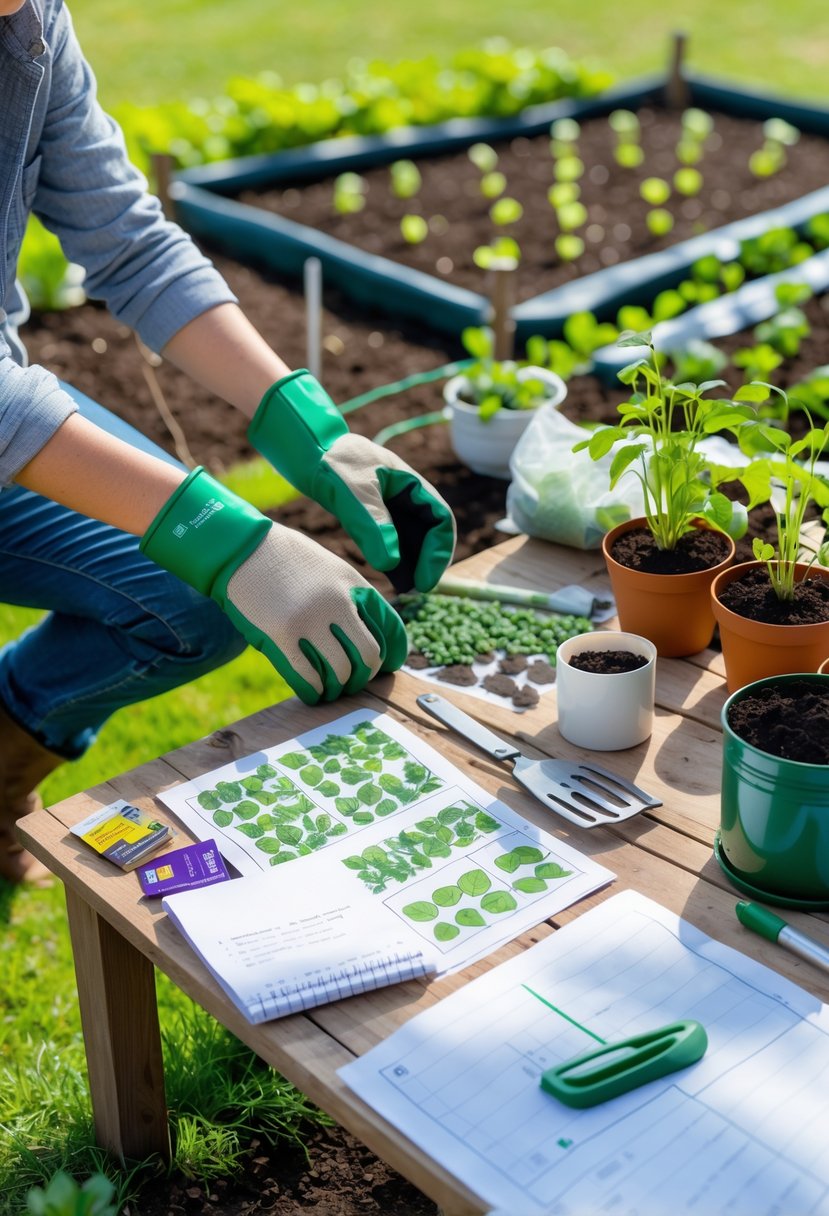
Starting a garden begins with careful planning. It is important to find a spot with enough sunlight, understand local climate conditions, and decide on the garden type and layout that fit your space and goals.
Choosing the Right Garden Location
A good garden location has at least 6 to 8 hours of direct sunlight daily. Most vegetables and flowers need this amount of sun to grow well. Observing the area throughout the day helps spot any shade caused by buildings or trees.
Good drainage is also key. Avoid places where water pools after rain, as this can harm plant roots. The soil should be easy to work with and nutrient-rich or suitable for improvement.
Accessibility matters too. The garden should be near a water source and convenient for regular care, like watering and weeding. Easy access encourages consistent attention, which is crucial for success.
Understanding Your Hardiness Zone
Knowing your USDA hardiness zone helps choose plants that can survive your area’s winter temperatures. The hardiness zone map divides regions by climate and cold tolerance.
Plants suited to your zone are more likely to thrive and require less maintenance. Checking your zone number online or with local extension offices is a simple step before buying seeds or plants.
This knowledge prevents planting species that will not survive outdoors. It helps plan the growing season and decide on crop types, including vegetables or perennials suited to your climate.
Selecting Garden Type and Layout
The choice of garden type affects maintenance, space use, and what plants can grow. Common options include traditional in-ground beds, raised beds, and container gardening.
Raised bed gardening is popular for better soil control and drainage. It reduces soil compaction and pests while making planting easier. Containers work well for small patios or balconies.
Planning the layout involves spacing plants based on growth needs. Rows, square foot gardens, or grouping by water needs help organize the space efficiently. A sketch or plan guides planting and future care.
Preparing Healthy Soil for Planting
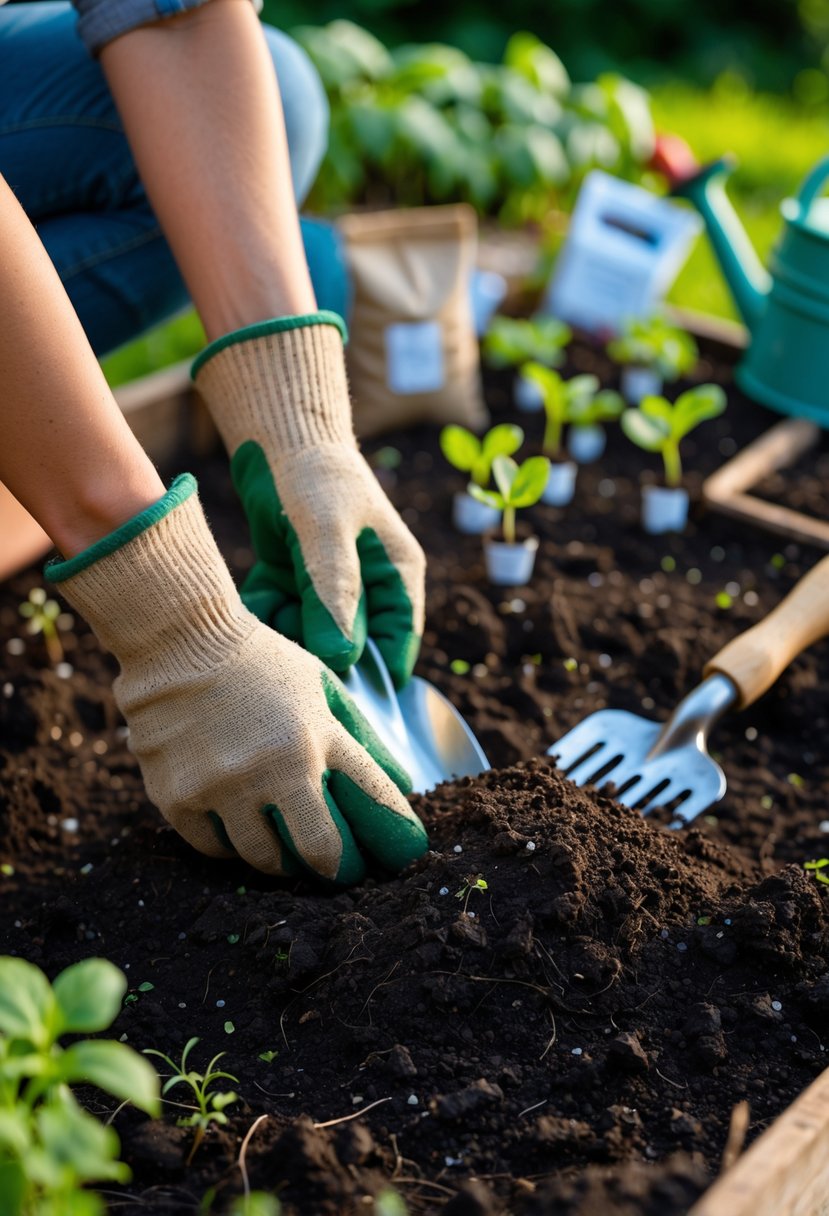
Healthy soil needs the right balance of nutrients, pH, and structure to support strong plant growth. Checking the soil first helps decide what to add. Adding compost and organic matter improves fertility and soil texture. Raised beds can be built or filled to create better drainage and soil control.
Testing and Amending Soil
Testing soil is the first step to understand what it needs. A soil test checks pH and nutrient levels. Most garden plants grow best in soil with a pH between 6.0 and 7.0. If the pH is too low (acidic), adding lime raises it. If it’s too high (alkaline), sulfur can lower it.
Knowing the soil type—clay, sandy, or loamy—helps choose the right amendments. Clay soils may need sand or organic matter to improve drainage and loosen the soil. Sandy soils benefit from added compost to hold moisture and nutrients better.
Adding organic fertilizers can supply missing nutrients based on test results. It’s important not to add too much fertilizer, which can harm plants and soil life.
Enriching With Compost and Organic Matter
Compost is decomposed plant material rich in nutrients. Adding compost improves soil fertility, structure, and moisture retention. It also supports beneficial microbes that help plants grow.
Mix compost into the garden soil before planting. A good rule is to add 2 to 4 inches of compost and work it into the top 6 to 8 inches of soil. Turn the soil gently to avoid harming its natural layers.
Organic matter, like shredded leaves or grass clippings, can be added as mulch on top of the soil. Mulch reduces moisture loss and controls weeds. Over time, this breaks down and enriches the soil further.
Building or Filling Raised Beds
Raised beds lift the growing area above the natural soil. This helps improve drainage and avoid soil compaction. Raised beds also allow better control over soil quality.
To build raised beds, use untreated wood or another durable material to form the frame. Fill with a mix of native soil, compost, and organic matter. A common soil mix is 40% topsoil, 40% compost, and 20% other organic matter like coconut coir or peat moss.
Raised beds warm faster in spring and can be easier to manage. They are especially helpful where native soil is poor or heavy clay. Regularly check soil moisture and add compost each year to keep soil nutrient-rich.
Sowing, Planting, and Garden Care Techniques
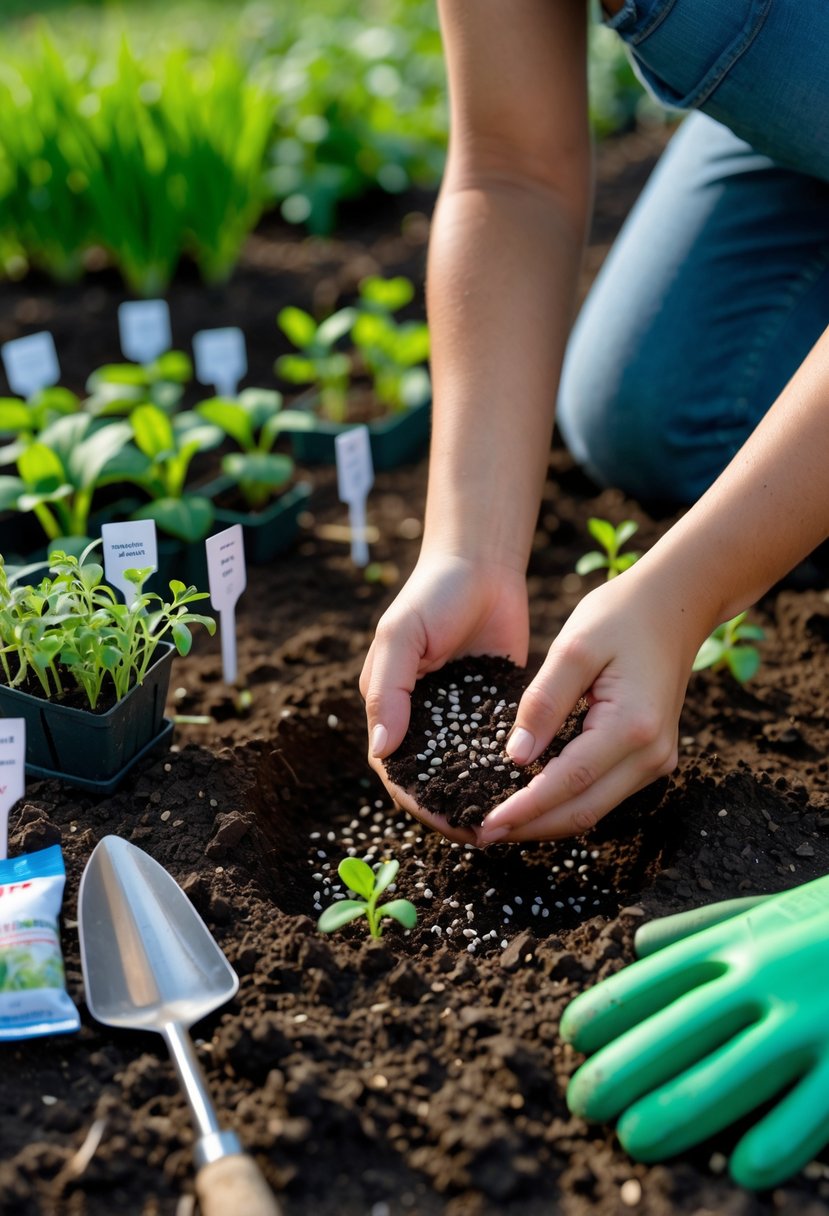
Starting a garden means careful planning of seed or seedling selection, placing plants with the right spacing, and keeping soil properly watered. These actions build the base for strong growth and healthy plants.
Choosing and Starting Seeds or Seedlings
Gardeners should pick seeds based on climate, soil, and season. Some plants do better when started indoors, like tomatoes or peppers, using seed trays or pots. Others, such as carrots or radishes, can be sown directly into the soil.
Seedlings bought from a nursery can save time but must be strong and healthy before planting outside. When transplanting seedlings, it is important to harden them off by slowly exposing them to outdoor conditions for about a week. This helps reduce shock and increases survival chances.
Using quality seed-starting mix rather than garden soil improves germination. Light, warmth, and consistent moisture encourage seeds to sprout.
Planting Methods and Spacing
Proper planting depth and spacing depend on the plant species. A general rule is to plant seeds at a depth about two to three times their size. For seedlings, dig a hole twice as wide as the root ball.
Spacing is key to avoid overcrowding that limits growth and airflow. Most vegetables need about 12 to 18 inches between plants, but this varies. Leafy greens, for example, can grow closer, while larger plants like squash or corn need more room.
Row spacing should allow easy access for weeding and watering. Raised beds or rows improve drainage and can make planting easier.
Watering Strategies and Soil Moisture
Consistent watering is essential to keep soil moist but not soggy. Overwatering can drown roots, while underwatering stresses plants. Drip irrigation or drip irrigation kits provide slow, steady water directly to roots, saving water and reducing disease risk.
Early morning watering is best to minimize evaporation. Checking soil moisture with a finger probe helps decide when to water. The soil should feel damp to a depth of 1-2 inches.
Mulching around plants conserves moisture and controls weeds. Adjust watering frequency when weather changes to match plant needs.
Maintaining and Protecting Your Garden
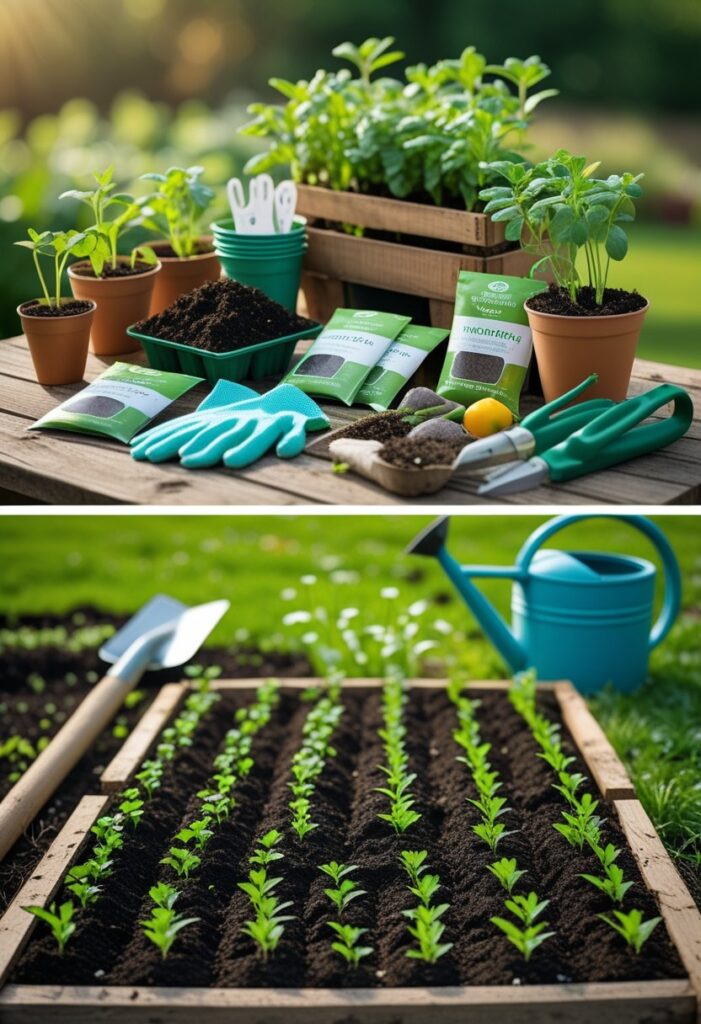
A healthy garden requires regular care focused on managing weeds, pests, and soil nutrients. Protecting plants while encouraging growth will help the garden remain productive and vibrant throughout the season.
Weeding and Mulching
Weeds compete with plants for water, sunlight, and nutrients. Removing them early and often helps the garden stay healthy. Pull weeds by hand or use a hoe to avoid disturbing plant roots.
Applying mulch around plants is important. Mulch controls weeds by blocking light and conserves soil moisture. Organic mulches like straw, wood chips, or shredded leaves break down over time, adding nutrients to the soil. A 2-3 inch layer is usually enough to suppress most weeds.
Mulching also helps regulate soil temperature, keeping roots cooler in summer and warmer in winter. This creates better growing conditions for plants and reduces the need for frequent watering.
Controlling Pests and Promoting Beneficial Insects
Pests like aphids can damage plants by sucking sap and spreading disease. Using insecticidal soap or neem oil sprays can control these pests without harming beneficial insects.
Encouraging beneficial insects such as ladybugs and lacewings is a natural way to protect the garden. Companion planting with flowers like marigolds or herbs such as basil attracts these helpful bugs. These plants also deter some harmful insects.
Gardeners should regularly check plants for signs of pests and remove infested leaves or stems. Maintaining plant health through proper watering and nutrition makes plants less vulnerable to damage.
Fertilizing, Pruning, and Maximizing Yield
Fertilizing is key to supporting plant growth. Using balanced fertilizers or compost improves soil fertility. Applying fertilizer according to the needs of specific plants avoids overfeeding, which can harm the garden.
Pruning helps direct energy towards fruit and flower production. Removing dead or crowded branches improves air circulation and light penetration. This practice reduces disease risk and encourages bigger harvests.
To maximize yield, gardeners can use companion plants that improve growth or repel pests. For example, planting beans near corn adds nitrogen to the soil, benefiting both crops. Proper care and timely harvesting keep the garden productive throughout the growing season.
Frequently Asked Questions
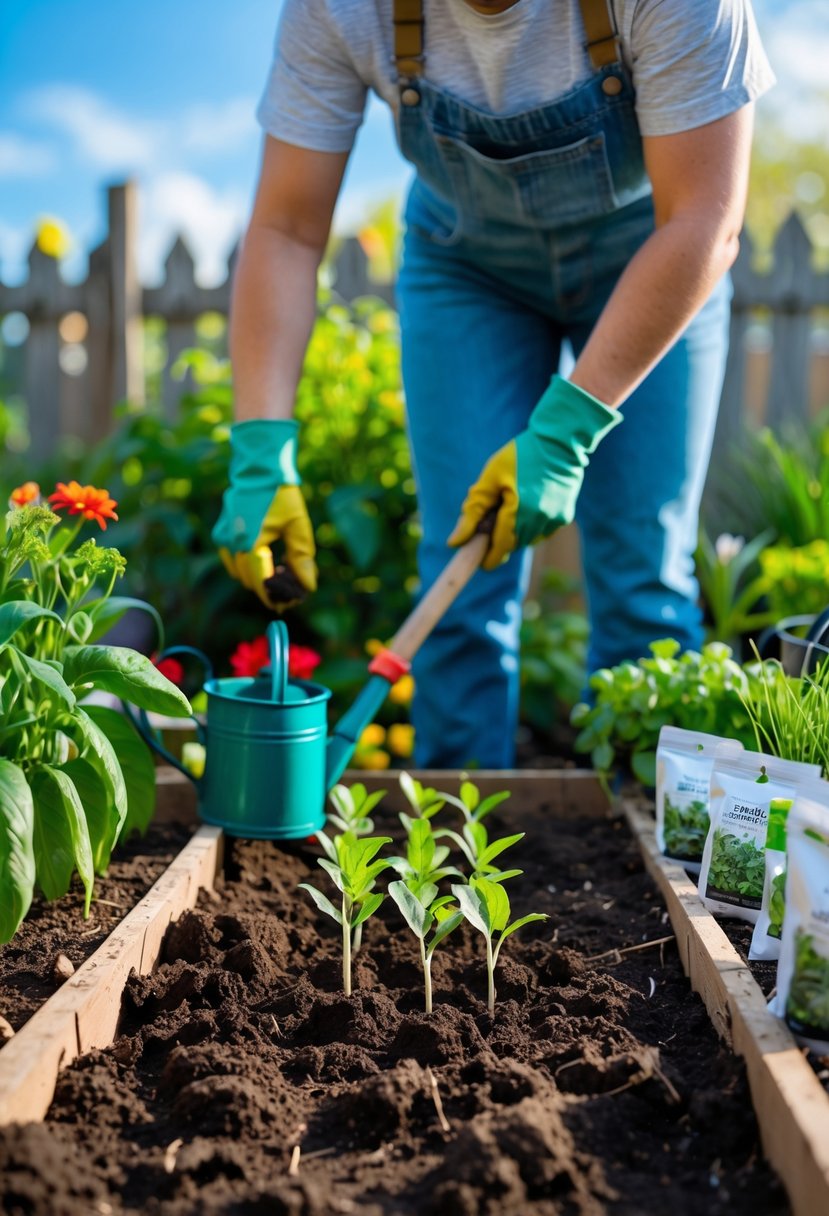
Starting a garden requires certain tools and careful site selection. Having the right equipment and picking a good location can improve the chances of a successful garden.
What essential tools do I need to start a garden from scratch?
Basic tools include a shovel, garden fork, hoe, and rake. These help prepare and turn the soil.
A hand trowel is useful for planting seeds or small plants. Gloves protect hands from dirt and sharp objects.
Watering cans or a hose with a spray nozzle make watering easier. A wheelbarrow can help move soil, compost, and plants.
What are the best practices for choosing a location for a new garden?
Choose a spot that gets at least 6 hours of sunlight daily. Most vegetables and flowers need full sun to grow well.
Look for flat or gently sloped areas with good drainage to prevent water pooling. Avoid spots near large trees or buildings that create too much shade.
Consider access to water and how easy the site is to reach for maintenance. Also, check the soil quality before planting.





